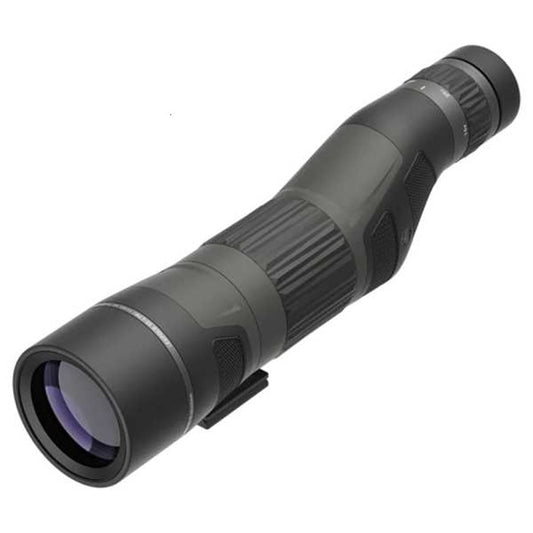

Leupold SX-4 Pro Guide HD Gen 2 Straight Spotting Scope 20-60x85mm offers high-definition performance for outdoor enthusiasts. Its rugged magnesium body ensures durability in harsh conditions, making it both waterproof and fogproof. The oversized eyepiece enhances comfort during long viewing sessions, while the straight eyepiece design allows for easier packing and quick target acquisition.
Equipped with Leupold's Elite Optical System, this spotting scope delivers exceptional light transmission and glare reduction for clear images at dawn and dusk. The Diamond-Coat lenses provide enhanced scratch resistance, and the Guard-ion coating repels dirt and moisture. With a close focus range of 35 feet and a magnification range of 20x to 60x, it adapts to various viewing needs, making it an essential tool for serious hunters and shooters.
Key Features:
- EXTREME DURABILITY for all-weather performance with a rugged magnesium body that is 100% waterproof and fogproof.
- OPTICAL CLARITY with Elite Optical System that ensures excellent light transmission and glare reduction for clear images.
- COMFORTABLE VIEWING provided by an oversized eyepiece that supports extended observation without strain.
- LIGHTWEIGHT DESIGN facilitates easy transport with a compact straight body style suitable for packing.
- QUICK TARGET ACQUISITION through a straight eyepiece that aligns with your line of sight for intuitive use.
- SCRATCH RESISTANCE with Diamond-Coat lens technology that protects against dirt and smudges.
- ADAPTABLE VIEWING featuring a close focus range of 35 feet, making it versatile for different environments.
- LONG-TERM RELIABILITY with a lifetime guarantee that promises repair or replacement if needed.
Technical Specifications Table
| Specification | Details |
|---|---|
| SKU | 18568X-Leupold-PARENT |
| UPC | 030317042233 |
| MPN | 185680 |
| Close Focus Range | 35' |
| Exit Pupil | 1.4mm - 4.1mm |
| Eye Relief | 19mm |
| Field of View | 50.6' - 91.7' @ 1000 yards |
| Height | 4.5" |
| Length | 14.5" |
| Magnification Range | 20x - 60x |
| Weight | 4 lbs |
| Width | 3.5" |
| Item Condition | New |
| Product Type | Spotting Scopes |
| Body Type | Straight |
| Eyepiece Included | Yes |
What's in the Box?
- Leupold SX-4 Pro Guide HD Gen 2 Spotting Scope
- Eyepiece cover
- Objective lens cover
- Padded carrying case
- Instruction manual
Customer Reviews
"This spotting scope exceeded my expectations in clarity and durability. Perfect for my hunting trips!"
"Lightweight, easy to carry, and the images are razor-sharp. Highly recommend!"
"Great value for the price. It performs well in low-light conditions."
FAQ
How does the SX-4 Pro Guide HD perform in low-light conditions?
Thanks to its Elite Optical System, this spotting scope excels in low-light situations, providing bright images even during dawn and dusk. Its advanced lens coatings reduce glare and enhance light transmission.
What maintenance is required for the spotting scope?
Regularly clean the lenses with a microfiber cloth to prevent scratches. Ensure that the scope is stored in a cool, dry place and avoid exposing it to extreme temperatures to maintain performance.
How does this model compare to other spotting scopes?
The SX-4 Pro Guide HD stands out with its combination of durability, optical clarity, and user-friendly design. Compared to other models, it offers a superior viewing experience, especially in challenging conditions.
Similar Models
Explore more options from Leupold for all your spotting needs. Check out the Leupold Golden Ring 15-30x50mm Spotting Scope for a compact alternative, or the Leupold Mark 4 12-40x60mm for enhanced magnification. Dive into our full collection to find the perfect optics for your adventures.
You May Also Like
Here’s some of our most similar products people are buying. Click to discover trending style.






